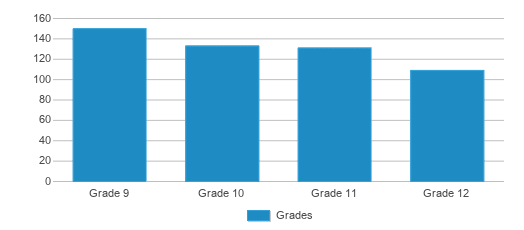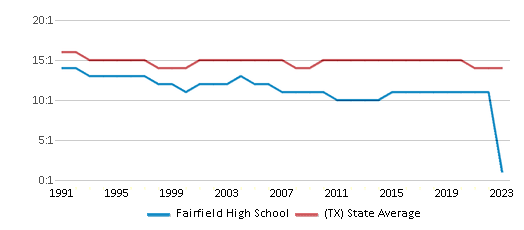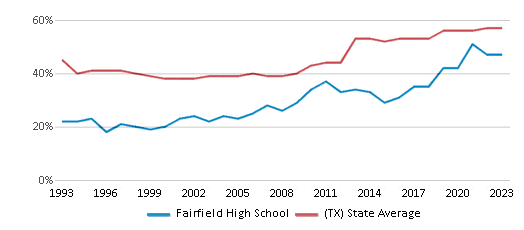Serving 523 students in grades 9-12, Fairfield High School ranks in the top 50% of all schools in Texas for overall test scores (math proficiency is bottom 50%, and reading proficiency is bottom 50%).
The percentage of students achieving proficiency in math is 35-39% (which is lower than the Texas state average of 41%). The percentage of students achieving proficiency in reading/language arts is 50-54% (which is approximately equal to the Texas state average of 51%).
The student:teacher ratio of 12:1 is lower than the Texas state level of 14:1.
Minority enrollment is 46% of the student body (majority Hispanic), which is lower than the Texas state average of 75% (majority Hispanic).
Quick Stats (2025)
- Grades: 9-12
- Enrollment: 523 students
- Student:Teacher Ratio: 12:1
- Minority Enrollment: 46%
- Graduation Rate: 90-94% (Top 50% in TX)
- Overall Testing Rank: Top 50%
- Math Proficiency: 35-39% (Btm 50%)
- Reading Proficiency: 50-54% (Top 50%)
- Science Proficiency: 55-59% (Top 20%)
- Source: National Center for Education Statistics (NCES), TX Dept. of Education
Top Rankings
Fairfield High School ranks among the top 20% of public schools in Texas for:
Category
Attribute
Science Proficiency
Student Attention
School Overview
Fairfield High School's student population of 523 students has stayed relatively flat over five school years.
The teacher population of 44 teachers has declined by 6% over five school years.
Grades Offered
Grades 9-12
Total Students
523 students

Gender %

Total Classroom Teachers
44 teachers

Students by Grade

School Rankings
Fairfield High School ranks within the top 50% of all 8,188 schools in Texas (based off of combined math and reading proficiency testing data).
The diversity score of Fairfield High School is 0.62, which is less than the diversity score at state average of 0.64. The school's diversity has stayed relatively flat over five school years.
Overall Testing Rank
#3786 out of 8188 schools
(Top 50%)
(Top 50%)

Math Test Scores (% Proficient)
35-39%
41%

Reading/Language Arts Test Scores (% Proficient)
50-54%
51%

Science Test Scores (% Proficient)
55-59%
46%

Student : Teacher Ratio
12:1
14:1

American Indian
n/a
n/a
Asian
1%
6%

Hispanic
26%
53%

Black
14%
13%

White
54%
25%

Hawaiian
n/a
n/a
Two or more races
5%
3%

All Ethnic Groups



Graduation Rate
90-94%
90%

Participates in the National School Lunch Program (NSLP)
Yes
Eligible for Free Lunch
46%
57%

Eligible for Reduced Lunch
7%
5%

School Statewide Testing
School District Name
Source: National Center for Education Statistics (NCES), TX Dept. of Education
Profile last updated: 02/09/2025
Frequently Asked Questions
What is Fairfield High School's ranking?
Fairfield High School is ranked #3786 out of 8,188 schools, which ranks it among the top 50% of public schools in Texas.
What percent of students have achieved state testing proficiency in math and reading?
35-39% of students have achieved math proficiency (compared to the 41% TX state average), while 50-54% of students have achieved reading proficiency (compared to the 51% TX state average).
What is the graduation rate of Fairfield High School?
The graduation rate of Fairfield High School is 90-94%, which is higher than the Texas state average of 90%.
How many students attend Fairfield High School?
523 students attend Fairfield High School.
What is the racial composition of the student body?
54% of Fairfield High School students are White, 26% of students are Hispanic, 14% of students are Black, 5% of students are Two or more races, and 1% of students are Asian.
What is the student:teacher ratio of Fairfield High School?
Fairfield High School has a student ration of 12:1, which is lower than the Texas state average of 14:1.
What grades does Fairfield High School offer ?
Fairfield High School offers enrollment in grades 9-12
What school district is Fairfield High School part of?
Fairfield High School is part of Fairfield Independent School District.
School Reviews
1 6/25/2020
WONDERFUL SCHOOL AND TEACHERS.
2 11/16/2015
We have raised 7 children and we have lived all over the country and been to at leat 10 different schools over the last 20 years. This school has been overly controlling, judgmental, and arrogant. Our son was a star football player at a 6A school before coming here and he was ignored and treated like crap all season. He was even blamed when other kids broke into the locker room on his team. He was put behind freshman who never showed up to practice and failed their classes. He was put into one game, and scored 3 times and ran over 350 yards on JV, the next week he was benched and told to play with the freshman, and even then he sat on the bench. They have not accommodated for his IEP plan, and we have to stay on the phone and fight with the counselor and teachers constantly because his teachers never update his grades online and assign him his makeup work on days he misses school. The school has been so hard on him he wants to quit football and high school all-together. After calling his head coach several times this fall, and talking to him, he replied to us, "Maybe you should go back to Houston because obviously you and your son do not like it here."
Review Fairfield High School. Reviews should be a few sentences in length. Please include any comments on:
- Quality of academic programs, teachers, and facilities
- Availability of music, art, sports and other extracurricular activities
Recent Articles

What Is A Charter School?
Explore the world of charter schools in this comprehensive guide. Learn about their history, how they operate, and the pros and cons of this educational innovation. Discover key facts about charter schools, including admission policies, demographics, and funding, as well as what to look for when considering a charter school for your child.

10 Reasons Why High School Sports Benefit Students
Discover the 10 compelling reasons why high school sports are beneficial for students. This comprehensive article explores how athletics enhance academic performance, foster personal growth, and develop crucial life skills. From improved fitness and time management to leadership development and community representation, learn why participating in high school sports can be a game-changer for students' overall success and well-being.

February 05, 2025
Understanding the U.S. Department of Education: Structure, Impact, and EvolutionWe explore how the Department of Education shapes American education, from its cabinet-level leadership to its impact on millions of students, written for general audiences seeking clarity on this vital institution.





